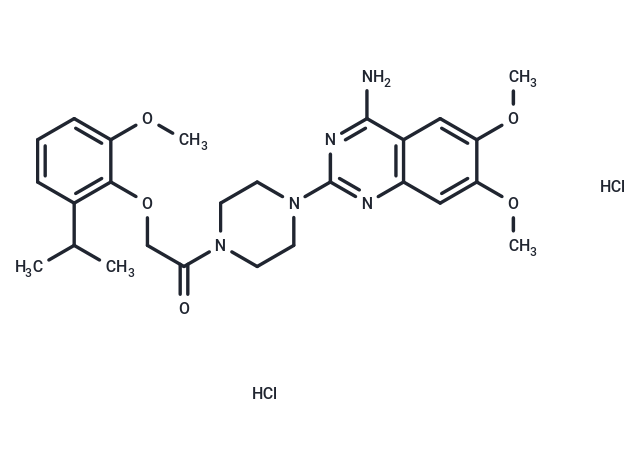 Your shopping cart is currently empty
Your shopping cart is currently empty

Rec 15/2615 is an antagonist of α1B-adrenergic receptors (α1B-ARs; Ki = 0.45 nM for the recombinant human receptor).1 It selectively inhibits α1B-ARs over α1A-, α1D-, and α1L-ARs (Kis = 7.59, 10.23, and 49 nM, respectively). Rec 15/2615 inhibits norepinephrine-induced contractions of isolated rabbit prostate and urethral strips (Kis = 100 and 316.2 nM, respectively), as well as reduces norepinephrine-induced contractions of chloroethylclonidine-precontracted isolated rabbit aortic rings (Ki = 50 nM).2 It decreases diastolic blood pressure (ED25 = 183 μg/kg, i.v.) and increases intracavernous pressure in anesthetized dogs when administered intracavernously at doses ranging from 30 and 1,000 μg/kg.1,2

| Pack Size | Price | USA Warehouse | Global Warehouse | Quantity |
|---|---|---|---|---|
| 25 mg | $1,468 | 1-2 weeks | 1-2 weeks | |
| 50 mg | $2,345 | 1-2 weeks | 1-2 weeks | |
| 100 mg | $3,750 | 1-2 weeks | 1-2 weeks |
| Description | Rec 15/2615 is an antagonist of α1B-adrenergic receptors (α1B-ARs; Ki = 0.45 nM for the recombinant human receptor).1 It selectively inhibits α1B-ARs over α1A-, α1D-, and α1L-ARs (Kis = 7.59, 10.23, and 49 nM, respectively). Rec 15/2615 inhibits norepinephrine-induced contractions of isolated rabbit prostate and urethral strips (Kis = 100 and 316.2 nM, respectively), as well as reduces norepinephrine-induced contractions of chloroethylclonidine-precontracted isolated rabbit aortic rings (Ki = 50 nM).2 It decreases diastolic blood pressure (ED25 = 183 μg/kg, i.v.) and increases intracavernous pressure in anesthetized dogs when administered intracavernously at doses ranging from 30 and 1,000 μg/kg.1,2 |
| Molecular Weight | 568.49 |
| Formula | C26H35Cl2N5O5 |
| Cas No. | 1782573-48-1 |
| Smiles | O=C(COC1=C(C(C)C)C=CC=C1OC)N2CCN(CC2)C3=NC4=C(C=C(C(OC)=C4)OC)C(N)=N3.Cl.Cl |
| Storage | Powder: -20°C for 3 years | In solvent: -80°C for 1 year | Shipping with blue ice/Shipping at ambient temperature. | |||||||||||||||||||||||||||||||||||
| Solubility Information | DMSO: 100 mM, Sonication is recommended. | |||||||||||||||||||||||||||||||||||
Solution Preparation Table | ||||||||||||||||||||||||||||||||||||
DMSO
| ||||||||||||||||||||||||||||||||||||
| Size | Quantity | Unit Price | Amount | Operation |
|---|

Copyright © 2015-2026 TargetMol Chemicals Inc. All Rights Reserved.